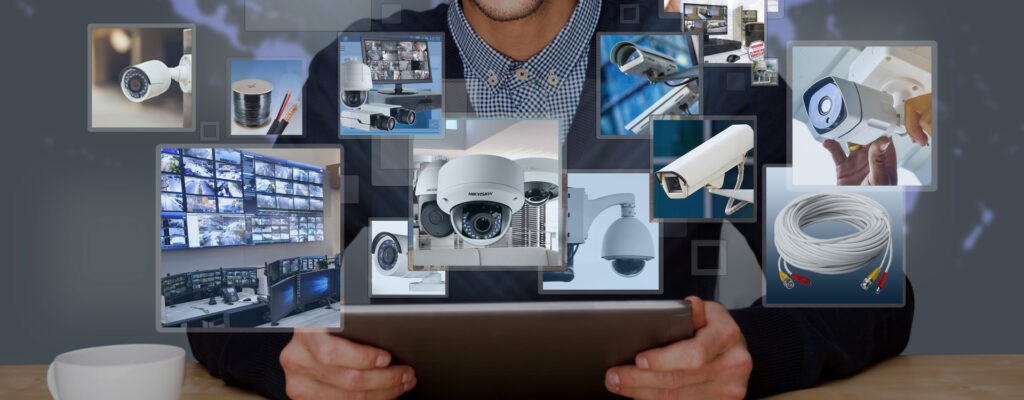
How CCTV Works ?
CCTV belongs to low voltage product family, which mostly runs on DC power of ranging 12V to 30V DC. In CCTV system there are four main components camera, recorder, storage & monitor. In CCTV system basic connection is that, we provide power to cameras ,cameras sends digital signal to recorder which process the data and store it on storage devices like hard disk & provide video output to monitor & through which we can see cameras operation. Below is the graphical representation of same, CCTV belongs to low voltage product family, which mostly runs on DC power of ranging 12V to 30V DC. In CCTV system there are four main components camera, recorder, storage & monitor. IN CCTV system basic connection is that, we provide power to cameras ,cameras sends digital signal to recorder which process the data and store it on storage devices like hard disk & provide video output to monitor & through which we can see cameras operation. Below is the graphical representation of same,
Although the basic concept of CCTV remains same but day by day as technology updates similarly there are so many advancement came in this segment too. Based on different parameters like technology, application, shape, CCTV system are classified in several types.
Based on technology CCTV system is divided in four types,
1) Analog system
2) HD System
3) IP System
4) Wireless System
In analog system basic components are, Cameras, Digital video recorder (DVR), Hard disk, Power supply, connectors and monitor. In any CCTV System image clarity is main concern point. In analog cameras Clarity parameter is measure in television lines i.e. 480TVL, 600TVL, 720TVL etc. In analog system cabling is to be done from each camera to DVR. With the help of BNC Connectors & DC Connectors cable connects cameras & DVR at both ends. Basically Co axial cable, 3+1 Cable & 4+1 Cable are used. From starting days of CCTV system, analog technology served to industry for so many years. But it had so many limitation like scalability, High storage, Bulky cabling etc. . To overcome these shortcomings two new technologies has been developed, one is HD CCTV System & second is IP CCTV System. In IP & HD Systems, Clarity of camera is measure in Megapixel i.e.1MP, 2MP, 4MP, 8 MP etc. Limitations of analog system are overcome in these two systems. In IP system bulk cabling is overcome by using Network switch in between the cameras & NVR. In IP system Network video recorder (NVR) is used in place of DVR. In IP system all cameras are having unique IP address so that it can be accessed from any other device like computer laptop or NVR.IP cameras are connected to network switch or POE Switch and then from switch to NVR or Server.
IP cameras clarity is much more than conventional analog cameras. As IP cameras are having the advantage of scalability, hence in all big projects like Airport, Railway station, Malls, mines, factories, Schools IP System is deployed. But main disadvantage of IP system is its price, Hence small establishments, residential projects, shops etc. avoid this system. To overcome this HD system is used which is exact advance version of analog system using same concept of working but with better clarity. In HD system also camera’s clarity is been measure in Megapixel’s i.e.1MP,2MP , 4MP etc. HD System is cheaper than IP System .Both system are having megapixel cameras but on clarity front HD camera is less than IP camera, similarly HD camera is better than Analog camera on clarity. Hence analog system is abandoned now. Fourth type is wireless system. In this system cameras are connected to centralised machine by wireless devices. One wireless device is used at camera end to transmit data signals & at another end wireless device is used to receive data from transmitter. In his system IP cameras are used. In IP system & wireless system catogary 6 cable is use for cabling work.
Type of cameras based on shape & Function of cameras,
- Dome Camera
- Bullet Camera
- Box Camera
- Veri focal Camera
- PTZ Camera
Special Purpose cameras & IoT Cameras
- Thermal Cameras
- People Counting Cameras
- Fish Eye Cameras
- VR Cameras
- IP Cube/Pocket Cameras
- Hidden Cameras or Spy Cameras
- Body Worn Cameras
- Solar Cameras
- Battery Operated Cameras
- Cloud based Cameras
- Automatic Number plate recognition Cameras (ANPR)
These cameras are mostly fall in IP Cameras Segment as these cameras works standalone also & for Storage memory card are used
